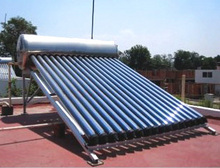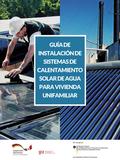Difference between revisions of "25,000 Solar Roofs Project"
***** (***** | *****) |
***** (***** | *****) |
||
| (3 intermediate revisions by 3 users not shown) | |||
| Line 1: | Line 1: | ||
| + | == '''<span style="color:#800000">Context</span>''' == | ||
| + | [[File:Mx-warmwasserkollektoren rdax 220x168.jpg|right|220px|alt=Mx-warmwasserkollektoren rdax 220x168.jpg]][[Mexico_Energy_Situation|Mexico]] is one of the countries hardest hit by climate change. As a result, climate protection features at the very top of Mexico's political agenda. One of the central challenges confronting the country is the need to reduce emissions in the energy sector, for example by increasing the use of renewable energy. With its high sunshine levels, Mexico possesses great potential for the use of solar energy, but to date this remains largely untapped. | ||
| − | '''<span style="color:#800000 | + | == '''<span style="color:#800000">Objective</span>''' == |
| − | + | The increased use of solar collectors for heating water in place of gas-operated systems reduces the greenhouse gas emissions caused by Mexican households.<span style="font-size: 0.85em"> </span> | |
| − | < | ||
| − | |||
| − | + | == '''<span style="color:#800000">Approach</span>''' == | |
| − | + | Modeled on Germany’s successful Market Incentive Programme, subsidies were awarded to cover the cost of investment for up to 25,000 solar collectors. Until the end of 2012, this was transacted through the credit system known as the ‘Green Mortgage’, administered by the National Workers Housing Fund Institute (INFONAVIT). With the introduction of this innovative subsidy model, Mexico assumed a pioneering role among developing and emerging countries. Since the award of subsidies ceased, the programme has given support to Mexican actors for designing initiatives intended to further the dissemination of solar collectors for heating water. | |
| − | + | == <span style="color:#800000">'''Results achieved so far'''</span> == | |
| + | [[File:Mx-warmwasserkollektoren rdax 220x168.jpg|right|220px|alt=Mx-warmwasserkollektoren rdax 220x168.jpg]] The first phase of the project contributed to the creation of access for low-income groups to a market-ready, extremely profitable technology which would otherwise have been beyond their reach because of the high initial investment costs. In addition, local production and service capacities have been built up in the field of solar energy. The Mexican state profits from the programme to the extent that it can reduce its gas subsidies. | ||
| − | < | + | == <font color="#800000">'''Documents'''</font> == |
| + | [[File:Guia CalentadoresSolares 03.pdf|thumb|left|thumb|120px]]<br/> | ||
| + | |||
| + | == <font color="#800000">'''Further Information'''</font> == | ||
| + | *[[Energy Efficiency in Buildings - Mexico|Energy Efficiency in Buildings - Mexico]] | ||
| + | *[[Mexican-German Programme for NAMAs - Housing Component|Mexican-German Programme for NAMAs - Housing Component]] | ||
| + | *[[NAMA Support Projects for Energy Efficiency in Buildings in Mexico|NAMA Support Projects for Energy Efficiency in Buildings in Mexico]] | ||
| + | *[[Mexican-German Triangular Cooperation between Mexico, Colombia and Germany: Fostering Sustainable Urban Development and Housing Construction|Mexican-German Triangular Cooperation between Mexico, Colombia and Germany: Fostering Sustainable Urban Development and Housing Construction]] | ||
| − | + | [[Category:Solar]] | |
| − | + | [[Category:Renewable_Energy]] | |
| − | + | [[Category:Mexico]] | |
| − | + | [[Category:Energy_Efficiency_in_Buildings]] | |
| − | [[ | ||
| − | |||
| − | [[Category: | ||
[[Category:Energy_Efficiency]] | [[Category:Energy_Efficiency]] | ||
| − | |||
| − | |||
| − | |||
| − | |||
| − | |||
| − | |||
| − | |||
Latest revision as of 11:28, 8 September 2017
Context
Mexico is one of the countries hardest hit by climate change. As a result, climate protection features at the very top of Mexico's political agenda. One of the central challenges confronting the country is the need to reduce emissions in the energy sector, for example by increasing the use of renewable energy. With its high sunshine levels, Mexico possesses great potential for the use of solar energy, but to date this remains largely untapped.
Objective
The increased use of solar collectors for heating water in place of gas-operated systems reduces the greenhouse gas emissions caused by Mexican households.
Approach
Modeled on Germany’s successful Market Incentive Programme, subsidies were awarded to cover the cost of investment for up to 25,000 solar collectors. Until the end of 2012, this was transacted through the credit system known as the ‘Green Mortgage’, administered by the National Workers Housing Fund Institute (INFONAVIT). With the introduction of this innovative subsidy model, Mexico assumed a pioneering role among developing and emerging countries. Since the award of subsidies ceased, the programme has given support to Mexican actors for designing initiatives intended to further the dissemination of solar collectors for heating water.
Results achieved so far
The first phase of the project contributed to the creation of access for low-income groups to a market-ready, extremely profitable technology which would otherwise have been beyond their reach because of the high initial investment costs. In addition, local production and service capacities have been built up in the field of solar energy. The Mexican state profits from the programme to the extent that it can reduce its gas subsidies.
Documents
Further Information
- Energy Efficiency in Buildings - Mexico
- Mexican-German Programme for NAMAs - Housing Component
- NAMA Support Projects for Energy Efficiency in Buildings in Mexico
- Mexican-German Triangular Cooperation between Mexico, Colombia and Germany: Fostering Sustainable Urban Development and Housing Construction





















